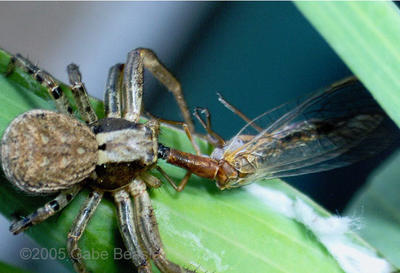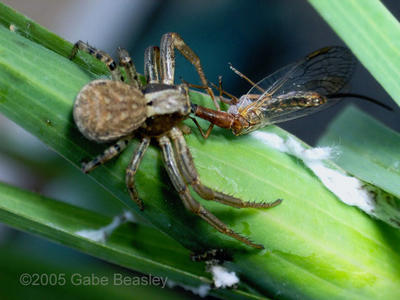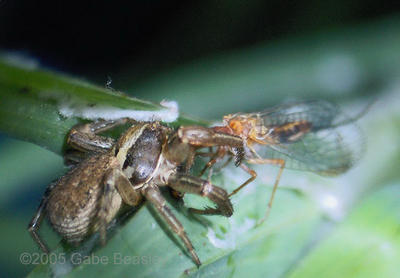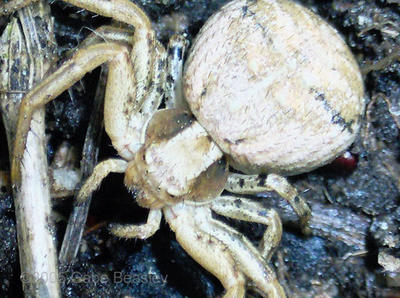This is the crab spider, one of my favorite shots I've got with one. They are very small around here at least for now--only about 5mm body. These are probably the Flower Spider, (Misumena vatia). Thomisidae (Crab spiders) are a fascinating type. They don't have spiny hairs or big fangs to defend themselves--but they do an incredible job of tackling the largest of pray. This one below is just caught a insect. Notice how the insect was bitten at the neck.


Like the big mammalian predators, most hunting spiders go for the neck. It's incredible but most insects actually have one, a soft one easy to bite. Even if they bite their pray somewhere else they will end up at the neck. It's for probably the same reason as large animals--the neck is near the nervous system and a quick way to kill. The neck is not broken or strangled here. It’s a quick way to pump poison into the brain. And yes, insects do have a brain. So if you want venom to act so fast you can't be hurt by dangerous pray, or you don't want it to get away so you can't find it--you have to bite your pray where it's going to die or be immobilized almost instantly. These wondering spiders don't have a lot of visible power as far as spiders go. Just a martial arts like "crab" stance that keeps them ready to strike and just out of strike range, good eyes, and a relatively tiny fangs when compared to other hunting spiders. There soft unprotected abdomen is almost a target--but they are fast, camouflaged and very dangerous to even the largest of pray.


Huge bees, wasps and other dangerous creatures are brought down by very small crab spiders. Their venom is so toxic to insects and their stance is so strong they are truly like the martial arts specialists of the spider world. Able to not only kill huge stinging dangerous pray like bumble bees, but hold them strong with fangs on a flower. They move around holding on in most cases until the pray dies--preventing it from flying off the flower or falling. From perspective they would look puny when matched to other hunting spiders--but this small spider packs a punch proving the silent, small shy type to be the most dangerous of all in the spider world.





 Like the big mammalian predators, most hunting spiders go for the neck. It's incredible but most insects actually have one, a soft one easy to bite. Even if they bite their pray somewhere else they will end up at the neck. It's for probably the same reason as large animals--the neck is near the nervous system and a quick way to kill. The neck is not broken or strangled here. It’s a quick way to pump poison into the brain. And yes, insects do have a brain. So if you want venom to act so fast you can't be hurt by dangerous pray, or you don't want it to get away so you can't find it--you have to bite your pray where it's going to die or be immobilized almost instantly. These wondering spiders don't have a lot of visible power as far as spiders go. Just a martial arts like "crab" stance that keeps them ready to strike and just out of strike range, good eyes, and a relatively tiny fangs when compared to other hunting spiders. There soft unprotected abdomen is almost a target--but they are fast, camouflaged and very dangerous to even the largest of pray.
Like the big mammalian predators, most hunting spiders go for the neck. It's incredible but most insects actually have one, a soft one easy to bite. Even if they bite their pray somewhere else they will end up at the neck. It's for probably the same reason as large animals--the neck is near the nervous system and a quick way to kill. The neck is not broken or strangled here. It’s a quick way to pump poison into the brain. And yes, insects do have a brain. So if you want venom to act so fast you can't be hurt by dangerous pray, or you don't want it to get away so you can't find it--you have to bite your pray where it's going to die or be immobilized almost instantly. These wondering spiders don't have a lot of visible power as far as spiders go. Just a martial arts like "crab" stance that keeps them ready to strike and just out of strike range, good eyes, and a relatively tiny fangs when compared to other hunting spiders. There soft unprotected abdomen is almost a target--but they are fast, camouflaged and very dangerous to even the largest of pray.
 Huge bees, wasps and other dangerous creatures are brought down by very small crab spiders. Their venom is so toxic to insects and their stance is so strong they are truly like the martial arts specialists of the spider world. Able to not only kill huge stinging dangerous pray like bumble bees, but hold them strong with fangs on a flower. They move around holding on in most cases until the pray dies--preventing it from flying off the flower or falling. From perspective they would look puny when matched to other hunting spiders--but this small spider packs a punch proving the silent, small shy type to be the most dangerous of all in the spider world.
Huge bees, wasps and other dangerous creatures are brought down by very small crab spiders. Their venom is so toxic to insects and their stance is so strong they are truly like the martial arts specialists of the spider world. Able to not only kill huge stinging dangerous pray like bumble bees, but hold them strong with fangs on a flower. They move around holding on in most cases until the pray dies--preventing it from flying off the flower or falling. From perspective they would look puny when matched to other hunting spiders--but this small spider packs a punch proving the silent, small shy type to be the most dangerous of all in the spider world.



No comments:
Post a Comment